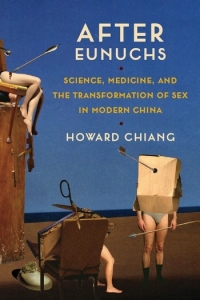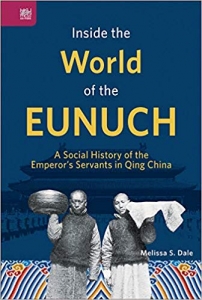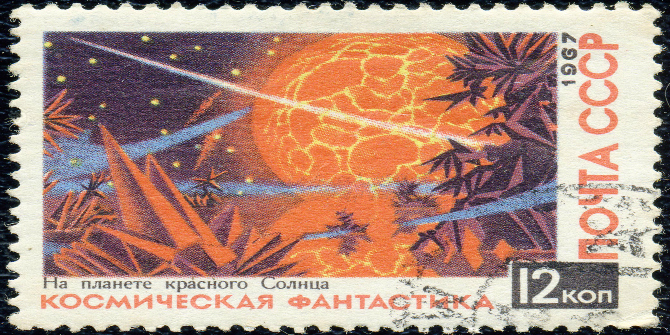Tom Marling reviews two recent studies that examine the institution of eunuchism towards the end of the Qing Dynasty in China, Inside the World of the Eunuch by Melissa Dale and After Eunuchs by Howard Chiang, reflecting on questions of agency and modernity as well as the historiographical challenge of building history from contradictory, compromised and fragmented source materials.
Inside the World of the Eunuch: A Social History of the Emperor’s Servants in Qing China. Melissa Dale. Hong Kong University Press. 2018.
After Eunuchs: Science, Medicine and the Transformation of Sex in Modern China. Howard Chiang. Columbia University Press. 2018.

 In China, the practice of eunuchism dates back to the first millennium BC, but historiographical traditions on the subject have largely been preoccupied with infamous instances of intrusion on the part of powerful eunuchs and eunuch cliques into the governance of the country. As a result, relatively little is known about some fundamental details of eunuchism ‘at large’, exacerbated by a paucity of source materials, as eunuchs themselves were deliberately kept illiterate and left few personal records.
In China, the practice of eunuchism dates back to the first millennium BC, but historiographical traditions on the subject have largely been preoccupied with infamous instances of intrusion on the part of powerful eunuchs and eunuch cliques into the governance of the country. As a result, relatively little is known about some fundamental details of eunuchism ‘at large’, exacerbated by a paucity of source materials, as eunuchs themselves were deliberately kept illiterate and left few personal records.
The past year has seen a relative deluge of new studies that run counter to these tendencies, all of which focus on the Qing Dynasty (1644-1912). While Norman Kutcher’s excellent Eunuch and Emperor in the Great Age of Qing Rule (University of California Press, 2018) concludes in 1800, just prior to the large-scale arrival of Westerners in China, for Melissa Dale and Howard Chiang, non-Chinese observations play central roles in their respective reflections on agency, modernity and the dénouement of eunuchism in China.
Dale’s Inside the World of the Eunuch offers a number of valuable new insights on the social and biological determinants of eunuch identity, and on the persistence and malleability of eunuchism as an institution in its waning years. The opening chapters, on the induction of boys and men into eunuchism, reflect on eunuchism-qua-economy and the eunuch-qua-commodity. Dale finds that eunuch-producing provinces like Zhili and Shandong were as affected by vacillations in the demand for their unique commodity as other communities might have been in the market for, say, salt or hardwood. Orchestrating the supply of eunuchs were the (possibly apocryphal) ‘daozijiang’ (or ‘knifers’), who functioned as everything from lay surgeons to human traffickers, from surrogate parents to employment agents, while also maintaining a lucrative sideline in the operation of a lending library for preserved genitalia (eunuchs’ ‘treasures’, or bao).
The book’s sweeping perspective affords the reader frequent opportunities to reflect on the reverberations of emasculation that ran through eunuchs’ lives. The physical severance of the genitals was accompanied by an equally traumatic social severance, just as the denial of the capacity for biological reproduction was reiterated in their enforced illiteracy. With the benefit of this context, castration comes to represent not a singular act, but something akin to what Arnold van Gennep called a ‘rite of passage’ – between discrete lives-within-a-life.
One of the many ironies of the eunuch experience was that even as they were ejected from ‘normal’ society, eunuchs were drawn into the most central, and most inaccessible, physical space of the nation. Court eunuchs were uniquely permitted to traverse the barrier between the inner (feminine) and outer (masculine) chambers of the Forbidden City, setting them up as purveyors of what Mitamura Taisuke called ‘intimate politics’. To this existing spatial insight, Dale contributes the valuable caveat that their freedom of passage within the Forbidden City was not matched by an equivalent capacity for passage out, be it from the palace itself or from eunuch service in general.
Chapter Six, ‘Running away from the Palace’, uncovers a trove of valuable first-hand accounts from captured eunuch escapees that reveal valuable details about their indigent experiences, and their harsh treatment and exploitation at the hands of more senior eunuchs, which often impelled their flight in the first place. Suffering not only frequent punishment and semi-imprisonment but also chronic medical conditions and social stigma, many eunuchs turned to suicide as a more permanent escape, despite harsh consequences for their families. Dale’s compilation and dissection of palace suicide reports find instances of suicide to have been worried over more in terms of their capacity for spiritual contamination of the sanctified spaces of the royal household than out of concern for the individual in question. In contrast to the standard investigative approach to suicide cases, little energy was expended on identifying possible instigators, in part because ‘the guilty party might well have been members of the Imperial Household and the eunuch management system’ itself.
One of the virtues of Dale’s study is the clear sense that it gives the reader of how, over the course of the Qing Dynasty, eunuchs were gradually denuded of their former influence, and transformed into little more than petty employees of the imperial bureaucracy. Disputes over faked illnesses and inadequate leave are expressions of what Dale calls ‘labor relations’: an apt term for an unexpectedly late modern dynamic that culminates in the book’s excellent final chapter, on the child emperor Puyi’s mass lay-off of the remaining court eunuchs, which occurred without warning on a rainy morning in 1923. The unexpected consanguinity between the precarity of the final generations of eunuchs in China and the late capitalist proletariat is palpable in this scene of mass termination, and in the somewhat tragi-comic rhetorical ideas for re-purposing them as otherwise productive members of society on the part of the Republican-era intelligentsia. As one such individual suggested sanguinely, finding new uses for eunuchs should have proved no more onerous than ‘get[ting] some more wear out of an old pair of pants by turning them into shorts’.
 Image Credit: Forbidden City (Michael Delli Carpini CC BY 2.0)
Image Credit: Forbidden City (Michael Delli Carpini CC BY 2.0)
Chiang’s After Eunuchs presents a fascinating genealogical dissection of the epistemology of gender mutability, intersexuality and transsexuality in modern Chinese history. For Chiang, the Western discourse surrounding eunuchism in the late Qing was one of the first incidences in which a biomedical episteme was grafted onto Chinese culture, irrevocably transforming it in the process, as other theorists have observed in contemporary discourses on hygiene (see Ruth Rogaski’s Hygienic Modernity) and footbinding (see Angela Zito). From this, he hypothesises that the turn against eunuchism also dissolved the traditional means of categorising and conceptualising intersexuality and transsexuality, leaving twentieth-century Chinese culture to rebuild its understandings of these concepts.
On the topic of eunuchism, Chiang’s insights are principally historiographical, but deeply important. In a tour-de-force of critical source analysis (what he calls ‘archival problematisation’), the first chapter asks simply: ‘what can we know about the history of castration [in China?]’ (my emphasis). Chiang convincingly lays out how the relative proliferation of source materials on eunuchs and castration in the late nineteenth and early twentieth century was the product of Western knowledge production intended for Western consumption. Although ‘fetishistic […] biomedical […] Christian and orientalist’ in its own right, this discourse also functioned in concert with others that collectively dehumanised Chinese culture as deviant and hidebound, often in the explicit terms of a ‘castrated civilisation’ (beiyange de wenming).
One of the few extant eyewitness accounts of castration, recorded by the Customs Service official George Carter Stent in 1877, is a key example of this. Stent’s detailed and ostensibly eyewitness description has been pervasive, serving as the basis for popular educational materials up until the present day. Chiang points out that as a source, it is valuable only by dint of its rarity, not by virtue of any apparent objectivity or impartiality on the part of its author. A self-professed proponent of the absolute superiority of Western values over Chinese ones, Stent openly viewed the practice of castration as a ‘vile social blot’ endemic to countries untouched by the ‘enlightening influence of Christianity’.
Historians’ reliance on Stent’s account has conveyed to it an ever greater authority, to the extent that its origins within a palpably orientalist discourse have become marginalised. In contrast, Sir Edmund Trelawny Backhouse’s picaresque 1943 memoir Decadence Mandchoue, rediscovered in Oxford University’s Bodleian Library in the 1970s, was totally discredited as a historical source, most notably in a prudish broadside by Hugh Trevor-Roper. Chiang’s recourse to this serial fabulist’s raunchy autobiographical account of getting topped by a eunuch to the court of Empress Dowager Cixi is a refreshingly playful reminder of the often ambiguous criteria by which truth and fiction have been delineated in the context of Western sources on eunuchism.
The Backhouse memoirs are unique not only in their depiction of a eunuch being sexually active, but also in their positioning of the eunuch’s body not as a passive specimen being exposed to the medical gaze, which became particularly prevalent with the rise of medical imagery around the turn of the twentieth century. Building on the work of Ari Larissa Heinrich, Chiang argues that the visual constitution of the eunuch through medical photography inextricably intertwined them with pathology, positioning them as ‘intrinsically deficient’. French physician Jean-Jacques Matignon’s arresting 1896 photograph is the most infamous example of this kind of visual language on eunuchism, shaped as it was by evident voyeurism and a clear sense that eunuchs were to be constructed outward from their absent genitalia. ‘The image that we are staring at’, Chiang suggests, ‘asks not what is wrong with the body of this eunuch per se, but what is wrong with China’.
While deconstructing one discourse, Chiang offers some productive suggestions on how to rebuild eunuch historiography. Western accounts understood castration in terms of its mitigation of biological reproduction and the removal of the penis, but Chiang’s provocative proposal is that while excising the tools associated with reproduction and masculinity, it also engendered new paradigms of masculinity and fecundity. Focusing on available accounts of eunuchs themselves, mostly recorded in the twentieth century, Chiang argues that castration – akin to Dorothy Ko’s characterisation of footbinding or Benjamin Elman’s analysis of the examination system – was ‘a mechanism of systemic gendering’. Chiang seizes on the rich semantic valences of being ‘born from within the inner quarters’ (menli chushen), a practice whereby a potential emasculee would undergo an apprenticeship with an older eunuch, who would then approve him for surgery. The ‘birth’ in this case being an instance in which culture was substituted for biology.
As with Dale, Chiang ends with the persistence of eunuchism beyond the lifespan of the Imperial system that it served. Again echoing footbinding, he notes that Western accounts of castration were important factors in bringing about the downfall of the institution that they recorded. Chiang tracks how anti-eunuch opprobrium was fostered in the global community, and then relayed back to China through the modernising intellectuals that desired to reform China along Western lines. Chiang’s narrative intersects with Dale’s at the moment that Puyi disbanded the remaining eunuchs, although the event is reframed by a greater focus on the anti-eunuch sentiments of his influential British tutor Reginald Johnston.
Chiang’s criticisms of the pre-eminent archival materials on eunuchism impact on Dale’s study. A number of Western accounts problematised by Chiang – including that of Stent – are reproduced by Dale with limited qualifications that are largely contained to the footnotes. Nor is this approach limited to the occluded topic of castration. Dale’s analysis of everyday eunuch society – which should be the conceptual centrepiece of this social history – is unfortunately burdened by the concept of ‘eunuch espirit d’corps’, a tellingly incongruent dualism that can be traced to the 1905 memoirs of American artist Katherine Carl. Carl’s interpretation inspires Dale’s own, oft-repeated, assertion that eunuch society ‘actively recreated the [familial] bonds that emasculation [… was] intended to deny them’ (my emphasis), which reproduces the dominant interpretative framework of castration as the excision of a heteronormative identity. Dale’s version of eunuch agency emphasises the contingent possibility of ‘de-castrating’ eunuchs. Chiang’s version of eunuch agency deliberately inverts this paradigm, arguing that rather than re-creating their own pre-castrated self, eunuchs found in castration a means by which to reproduce themselves as eunuchs.
Both After Eunuchs and Inside the World of the Eunuch reflect on the complications of building history from source materials that are compromised and fragmentary. Dale attempts to weave a broad tapestry that in places it runs to threadbare, while the same limitations inspire in Chiang an epistemological reflection on the inaccessibility of the past. While this may strike some as fatuously postmodern, it is a valuable reminder of the inherent power relations that shape histories of marginal communities.
Tom Marling has a PhD in History from Hong Kong Baptist University. His research interests include late-Qing tabloid fiction and the urban environment of Shanghai, and the history of pre-CCP organised labour in south China. He is one of the co-editors of Collected Essays of To the Seas and Beyond: An International Conference on the Maritime Silk Road (Hong Kong Museum of History and Hong Kong Baptist University Department of History, 2018).
Note: This review gives the views of the author, and not the position of the LSE Review of Books blog, or of the London School of Economics.






